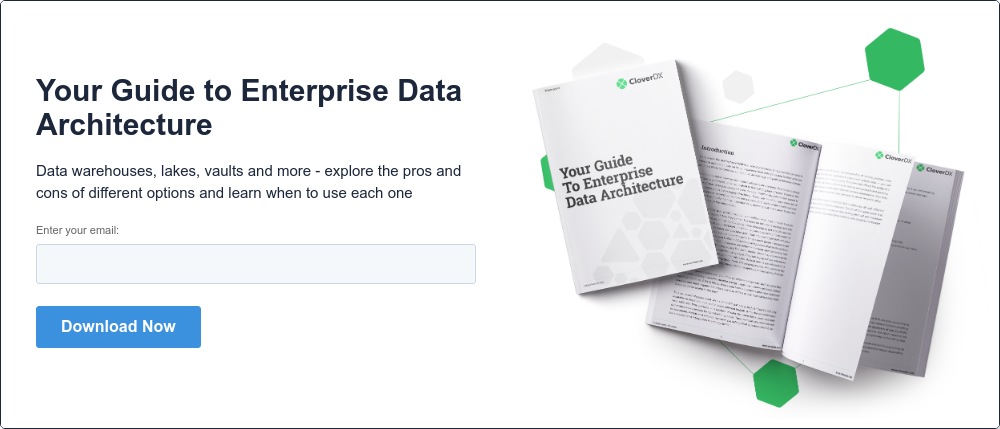Are you struggling to make the most out of your data? Perhaps it’s inaccessible and you can’t extract timely business insights. Perhaps there’s too much to handle (and a portion of it’s low-quality).
Maybe your data teams are working hard to establish good data management but are discouraged as only 13 percent of organizations excel at delivering on their data strategy.
Well, you’re not alone…
To clean up the mess and deal with the unprecedented amounts of data coming in, companies need to build solid modern enterprise data architecture.
What is Enterprise Data Architecture (EDA)?
Here’s a quick definition of what an enterprise data architecture is:
Enterprise Data Architecture is a set of policies that define how your enterprise collects, integrates, uses, and manages your data assets.
In the words of Dataversity, the purpose of enterprise data architecture is to ‘keep the supportive data framework clean, consistent, and auditable.’
It’s more than just a set of rules: it’s a discipline.
Designed and managed by your data teams, data architecture at an enterprise level standardizes the processes involved in managing data. This helps to maintain high quality, availability and governance. It also ensures there’s a steady stream of reliable, consistent, and organized data on hand at all times to provide business insights. Solid architecture bridges the gap between your technical teams and your business strategists—helping them work together towards long-term organization goals.
Enterprise data architecture isn’t a new concept. Many organizations apply it to their internal infrastructure and on-prem systems. However, these outdated systems are static and can’t adapt easily to changing requirements. They require high maintenance and financial investment, meaning low returns on investment.

The modern approach
Modern enterprise data architecture (MEDA) takes the principles of traditional data architecture and applies them to your complex big data demands. With an emphasis on flexibility and scalability, MEDA seeks to push past the limitations of your traditional systems, helping you manage your data volumes for effective analysis.
Here are some key principles for designing your MEDA:
- Centralize your data management. Data silos cause problems. MEDA breaks down your silos and replaces them with a centralized system. This increases your data visibility across your enterprise and allows you to correlate data from different business functions.
- Restrict your data movement. In traditional architecture, data movement is costly, time-consuming and has the potential to create errors. By supporting parallel processing of data sets across multiple workloads, MEDA restricts data movement. This optimizes your costs and keeps errors to a minimum.
- Curate your data. Data curation has a few different meanings, but essentially it’s about managing the data in your organization and connecting stakeholders across departments. Data curation typically includes cleaning raw data, transforming data, and setting data dimensions. Designing your MEDA with this in mind helps you unlock the potential of your shared data and improves the overall user experience.
- Create a common vocabulary. It’s no use if everyone’s speaking a different language when it comes to your data. MEDA helps you define your data consistently throughout the enterprise, ensuring definitions are comprehensive and understandable to all users. This helps minimize disputes and keeps your teams on the same page.
Following these principles helps you create solid architecture that benefits everyone in your business, not just your data teams. But, to make the most out of MEDA, there are a few more things you should keep in mind.
3 considerations of Modern Enterprise Data Architecture
1. Maintaining data privacy
You need to design your architecture with data privacy in mind.
Data privacy isn’t the same as data security. It’s about ensuring only the relevant people in your organization have access to personal or sensitive information.
For example, in a banking situation, only specific staff will need to know the personal information behind the accounts they work with. It doesn’t need to be common knowledge in your wider organization.
With MEDA, you’ll achieve this by setting the correct access controls on your systems to protect sensitive information.
Cloud platforms will have different tools and features to help you achieve this. In AWS, for example, you can use AWS Identity and Access Management and CloudTrail.
2. Automation
Automation is one of the big benefits of MEDA, and you should be using it. AI and machine learning play important roles in allowing databases to manage themselves.
Tasks that you should automate include:
- Infrastructure provisioning
- Application deployment
- Performing regular backups
- Data ingestion
This keeps your infrastructure running efficiently, without the need for continual staff maintenance. You can’t automate every task you have, but you should strive to automate as much as possible. If you’re using cloud platforms, many providers offer automation services. Some popular choices include:
- AWS Config, AWS CloudFormation, AWS EC2 Systems Manager.
- Microsoft Azure Resource Manager, Azure Automation.
3. Validation
If you’re processing data from an outside source, you need to assume there will be validity and quality issues.
We’ve talked about the importance of data quality many times, and it’s just as critical when it comes to managing your MEDA. The data processes you design need to have some sort of validation built in. Implementing data validation checks will prevent issues down the line.
Luckily, you can automate these checks too. CloverDX’s Validator filtering tool lets you visually define data quality rules and filter incoming data. For popular cloud platforms, you can use tools like Google Cloud’s DVT.
Regardless of the sophistication of your MEDA, make sure you only put high-quality, validated data into your systems. That way, you can ensure your business insights are high quality too.
Solid architecture means strong data
The data “high achievers” are the organizations that implement sturdy and structured Enterprise Data Architectures. These are the companies that deliver with measurable business impact.
Creating a solid MEDA foundation will improve the management of your data volumes and ensure high quality data for your business insights.
Looking to learn more about enterprise data architecture? Our white paper explores the benefits, drawbacks and challenges of common data architectures and best practices for building them.
By CloverDX
CloverDX is a comprehensive data integration platform that enables organizations to build robust, engineering-led, ETL pipelines, automate data workflows, and manage enterprise data operations.









